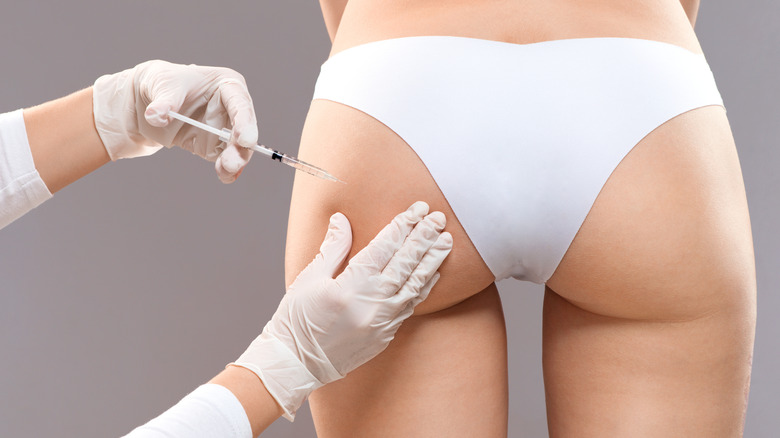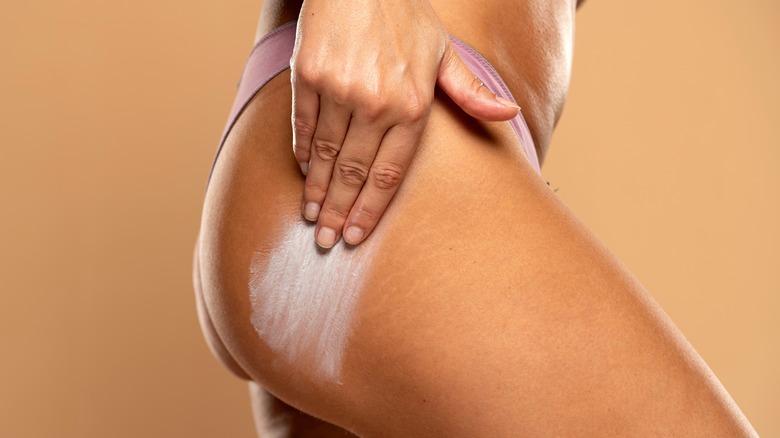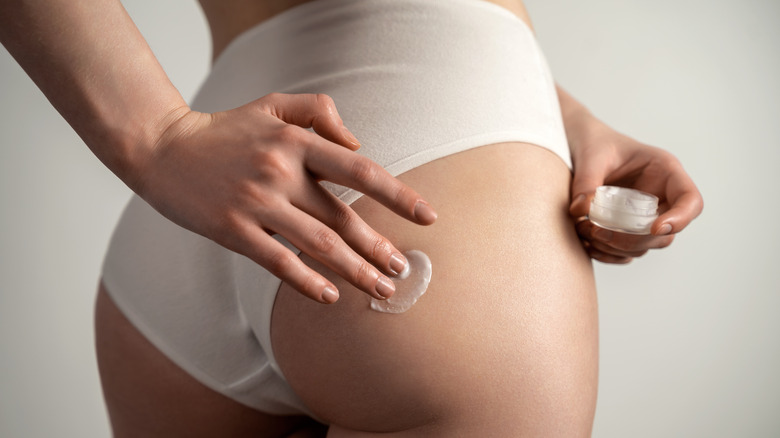How To Give Butt Acne The Boot
There's no right time or place for a breakout, but body acne can be incredibly irritating. Body acne can take many forms, primarily affecting the shoulders, back, and chest. However, one commonly affected area is particularly obnoxious to find new spots on: the butt.
Even if you don't feel like displaying your derrière, bum acne can be a serious cause of annoyance. Many of us spend a fair amount of time in seated positions, which can exacerbate spots and delay the healing of backside breakouts. It's also a bit trickier to pin down the origins of body acne –- while it's common knowledge that dirt and oils can lead to pimples, it turns out that trunk acne behaves differently than expected. Research published in the scientific journal Dermatology analyzed the skin of acne sufferers and found that their backs had lower sebum concentrations than their faces, indicating there may be more to learn about what causes body acne.
Furthermore, some dermatologists are divided on the diagnosis of butt acne. What we identify as zits could be another condition, like folliculitis. "Butt acne is usually not true acne, but rather folliculitis, which is a mild infection of the hair follicle that leads to red bumps," dermatologist Dr. Joshua Zeichner tells Women's Health. Don't stress about which type you have, however; you can address both using similar treatments. Though they can be difficult to narrow down, there are tried and true methods when it comes to preventing acne of the posterior. Ready to find out how to eliminate bum blemishes for good?
Easy solutions to get rid of butt acne for good
The first step to reducing butt acne involves everyone's favorite chore: laundry. Poor laundry habits can intensify your breakouts, from bacteria buildup to infrequent washing. "Wash clothes, towels, and sheets regularly, as bacteria can be transferred to your skin as well," dermatologist Michelle Green advised Allure. To put it bluntly, you should probably wash your linens more often than you think. In a survey conducted by Business Insider, less than 20% of respondents said they washed their towels enough to prevent bacteria overgrowth.
Next, consider your topical treatments. This may come as no surprise to acne veterans, but salicylic acid and benzoyl peroxide are two gold standard ingredients to look for in acne products. According to research published in The Journal of Clinical and Aesthetic Dermatology, salicylic acid gently exfoliates your skin, whereas benzoyl peroxide relies on its antibacterial properties to reduce blemishes. "The skin on the body tends to be tougher than the skin on the face, so it can usually tolerate stronger treatments," Dr. Hadley King tells Real Simple. So even if you've had difficult experiences with certain topicals for facial acne, they may be worth trying on body breakouts.
If you have troublesome pimples that stand out more than others, try using tea tree oil as a gentle spot treatment. "Tea tree oil has great natural antimicrobial properties. Dab a drop or two on the infected area with a cotton ball," Dr. Deanne Robinson tells Elle.
An unusual treatment for stubborn buttne or folliculitis
If you've struggled with body acne over the years, you've likely tried just about everything to treat it. But something you might not have considered is an antiseptic skin cleanser, which some say is just the trick to stopping stubborn butt acne. "After some trial and error, I discovered a specific method that COMPLETELY got rid of folliculitis," Redditor OliviaRose______ writes. She suggests a product containing chlorhexidine gluconate, like CVS Health Antiseptic Skin Cleanser, a clear, generic version of its pink-hued counterpart, Hibiclens. Olivia said that she mixed a small amount of the cleanser into Eucerin Eczema Relief Body Creme to create a lotion and applied it to the affected area twice daily. What's more, Redditor National_Chicken375 praised the concoction, writing, "I was folliculitis bump-free in three days. It was a miracle cure and has kept me [clear] for three months."
Although this remedy has received praise, it requires some caution. Many skincare ingredients come with some degree of risk, and this one is no exception. In rare cases, the active ingredient, chlorhexidine gluconate, can lead to skin irritation or allergic reaction (via The U.S. Food and Drug Administration). It's also crucial to avoid getting it near your eyes; chlorhexidine gluconate can cause irritation or damage to delicate eye tissue, according to research published in The Journal of the American Medical Association. As with any new active ingredient in your routine, it's always wise to make an appointment with your dermatologist and conduct a patch test before use.


